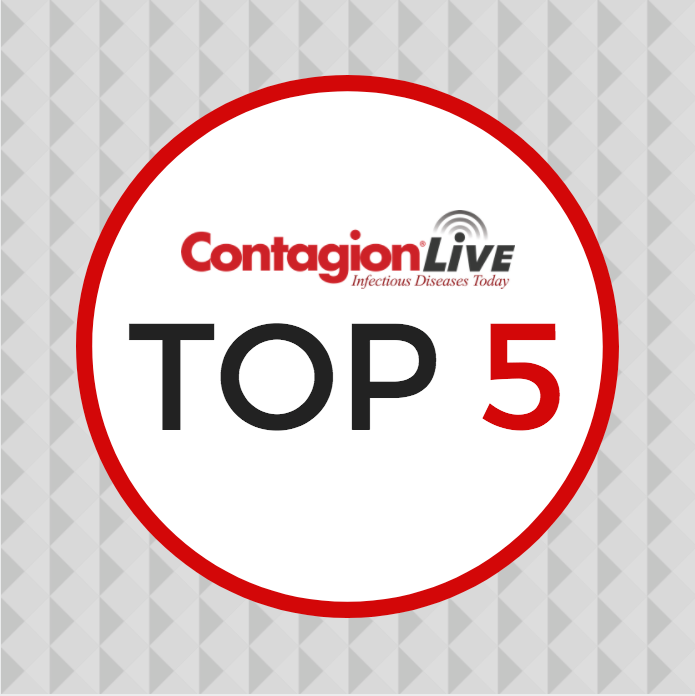Top Infectious Disease News of the Week—June 17, 2018
In case you missed them, we've compiled the top 5 articles from this past week.

#5: Capillary Blood Outperforms Venous Samples in Malaria Diagnosis
New research suggests that capillary blood samples are preferable to venous blood samples when attempting to detect malaria.
The study could change the way blood samples are taken in malaria-prone countries and also alter how researchers interpret data around malaria rates.
Researchers from Germany, Austria, and Gabon collaborated on the study, which involved quantifying parasitemia in capillary (CAP) and venous (VEN) samples, as well as evaluating the performance of the laboratory workers who were analyzing the samples. A quantitative polymerase chain reaction (qPCR) gold standard was used as the control against which to assess parasite counts and technician performance.
Read more about malaria study.
#4: Parent Cleansing Reportedly Reduces Skin Infections in Infants
Neonatal intensive care units (NICU) have been encouraging parents to engage in skin-to-skin care with their premature infants to aid in development. However, in a Michigan children’s hospital, staff noticed an increase in Staphylococcus aureus (S aureus) infections in newborns, hypothesized to be connected with skin-to-skin contact.
The research was presented at the 45th Annual Conference of the Association for Professionals in Infection Control and Epidemiology (APIC).
Read more about preventing skin infections in infants.
#3: Infection Prevention Gaps Found Across Critical Access Hospitals
One of the most fascinating studies presented at the 45th Annual Conference of the Association for Professionals in Infection Control and Epidemiology (APIC) delved into infection prevention and control gaps at critical access hospitals.
The infection prevention field is broad and as such, a hospital infection preventionist (IP) will cover everything from communicable disease surveillance to health care-associated infection investigations, to construction risk assessments and isolation rounding every day. Given the vast spectrum of things that fall under the infection prevention umbrella, it’s not surprising to see how diverse the gaps and failures can be.
Before considering infection prevention gaps, it is critical to address staffing of infection prevention and control programs within health care facilities. A recent study found significant gaps in IP staffing in American hospitals and underscored that there should be 1 IP for every 69 beds for true oversight.
Read more about infection prevention gaps in critical access hospitals.
#2: Implants for Delivery of Antiretroviral Drugs for HIV Pre-Exposure Prophylaxis
Strategies to reduce new HIV infections span multifaceted efforts, including safe-sex counseling, voluntary medical male circumcision, treatment as prevention, and pre- (PrEP) and postexposure prophylaxis. PrEP entails the use of antiretroviral (ARV) drugs prophylactically by HIV-negative individuals at risk of infection to thwart acquisition of the virus.
In 2012, the US Food and Drug Administration (FDA) approved Truvada, a daily oral pill for PrEP comprising 2 reverse tran­scriptase inhibitors, tenofovir disoproxil fumarate (TDF) and emtricitabine (FTC). This landmark approval was followed by approval from several other countries in North America and South America, Europe, and Africa. Support for oral PrEP emerged through pivotal randomized controlled trials inves­tigating Truvada in men who have sex with men (MSM), serodiscordant heterosexual couples in Kenya and Uganda, heterosexual men and women in Botswana, and users of injec­tion drugs in Thailand. The 2015 guidelines from the World Health Organization recommend oral PrEP for all populations at significant risk of HIV infection.
Read more about ART implants for HIV PREP.
#1: Two-Drug HIV Regimen May Control Virus in Treatment Näive Patients
ViiV Healthcare reported positive results from 2 phase 3 studies which were designed to evaluate the safety and efficacy of a 2-drug regimen of dolutegravir and lamivudine in comparison with a 3-drug regimen for treatment-naïve patients with HIV.
GEMINI 1 and GEMINI 2 are duplicate, phase 3 randomized, double-blind, multicenter, parallel group, non-inferiority studies. The GEMINI studies are part of ViiV Healthcare’s innovative clinical trial program for 2-drug regimens that seeks to reduce the number of medications used in HIV treatment in order to address long-term toxicity concerns.
The studies included approximately 1,400 participants that are treatment naïve HIV-1 infected adults with baseline viral loads less than 500,000 copies per ml. The studies were conducted at research centers in Europe, Central and South America, North America, South Africa, and the Asia Pacific.
During the course of the study, participants either received dolutegravir/lamivudine or dolutegravir and tenofovir disoproxil fumarate/emtricitabine. According to ViiV Healthcare, the studies met their primary endpoint for non-inferiority based on plasma HIV-1 RNA <50 copies per milliliter a standard measure of HIV control at week 48. According to the researchers, patients who experienced virologic failure did not develop treatment-emergent resistance.
“The GEMINI studies demonstrate the potency, safety and tolerability of the dolutegravir plus lamivudine combination. They affirm our two-drug regimen strategy and reinforce our belief that many patients can control their disease with two drugs instead of three or more. Importantly, the studies show that this two-drug regimen could be an option for treatment naïve patients and can support a broad range of patients living with HIV around the world,” said John C. Pottage, Jr, MD, chief scientific and medical officer of ViiV Healthcare in a statement.
Read more about the two-drug HIV regimen.
